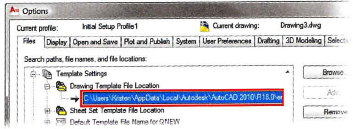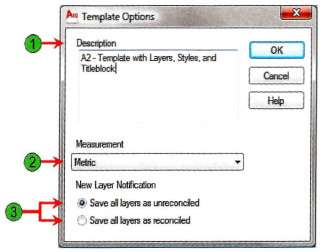Lesson 52 | Creating Drawing Templates
This lesson describes how to create drawing templates.
By creating drawing templates, you save time with every new drawing that you create. The settings in the drawing template are carried over to each new drawing that is created by using the template.
The following illustration shows the Template Options dialog box with measurement units, description, and new layer notification.

Objectives
After completing this lesson, you will be able to:
- Describe drawing templates.
- Identify various options of drawing templates.
- Create drawing templates.
About Drawing Templates
Drawing templates are extremely helpful in situations where you need to create your drawings with predefined drawing standards, such as layers and text styles. Using drawing templates enables you to save the time that you would have to otherwise spend in setting the required standards every time you begin a drawing. Many organizations have CAD Managers who create template drawings and make them available for their team.
The software provides various drawing templates for creating new drawings. Most of the predefined drawing templates are suitable for creating basic drawings. However, you can use these predefined drawing templates to create your own set of templates specific to your drawing requirements.
Definition of Drawing Templates
A drawing template is a collection of standard predefined settings, such as units, title blocks, layers, text styles, and dimension styles, which can be used for creating many drawings. Drawing template files have a .dwt file extension.
Drawing Templates and CAD Standards
When you work in a project where many people are involved in creating a design, there is a possibility that all team members do not consistently follow the same drawing settings. Therefore, to maintain consistency across drawings, you can establish CAD standards by sharing and using DWT files.
To create a DWT file, you define the required drawing settings and save the file as a drawing template. You can also save a DWT file as a drawing standard (DWS) file. You can then use a DWS file to check and map a drawing with a drawing template for any violation of the set standards.
Tip
After creating a drawing which is based on a DWT file, if you modify the new drawing, the changes do not affect the DWT file.
![]()
Example of Drawing Templates
The following illustrations show various examples of drawing templates.

An architectural template title block

A drawing template with D-size title block settings
Drawing Template Options
When creating drawing templates, you can save all or some of the template properties and settings, based on the type of drawings that can be created with a new template. You can modify these properties later, if required.
Template Properties and Settings
You use drawing templates to provide a starting point for all the new drawings that you create. In most design environments, your drawings share some common properties and settings. When you save a drawing template, you can save all the drawing commonalities, eliminating the need to create or adjust properties and settings each time you create a new drawing.
The following are some of the properties and settings that you can save in a drawing template:
- Unit settings
- Layers
- Snap, grid, and ortho mode settings
- Limits
- Dimension styles
- Text styles
- Linetypes
- Table styles
- Layouts
- Page setups for all layouts and model space
- Title blocks and borders
- Blocks, such as symbols or other objects, that you commonly use in your drawings
Template File Location
Before you create your drawing templates, you need to specify their storage location.
You specify where template files are stored on the Files tab of the Options dialog box. By default, this path is set to a subfolder of the current user folder. This path might work if you are working in a single user environment, but if you are working as part of a design team, you should set the path to a network location where all project drawing templates can be consolidated.
The path that you select controls the default location that appears when you select the Drawing Template (*.dwt) format in the Files of Type list in the Save Drawing As, Select Template, and Select File dialog boxes.

Template Options Dialog Box
By using the Template Options dialog box, you can set the drawing units to either imperial or metric, provide a description for the template, and control new layer notification.
To access the Template Options dialog box, you select the AutoCAD Drawing Template (*.dwt) option from the Files of Type list in the Save As dialog box.
Command Access

The following illustration shows the Template Options dialog box.

| Description - Specifies a description for the DWT file. This description is displayed in the Create New Drawing dialog box. | |
| Measurement - Determines whether drawings based on this template use English or Metric units. | |
| New Layer Notification - All the layers in a DWT file are saved as unreconciled by default. Saves all layers as unreconciled or reconciled. When you save a DWT file with unreconciled layers, the layer baseline is not created; therefore the new layer notification is not displayed. When you save a template with reconciled layers, layer baseline is created; therefore the software notifies you of any new layers in the drawing. |
Creating Drawing Templates
Creating drawing templates saves time. It enables you to start a drawing with the required predefined settings of layers, linetypes, and dimension styles. You can also import settings from other templates into the current drawing to create a new template.
Procedure: Creating Drawing Templates
The following steps describe how to create a drawing template:
- Create a new drawing by using an existing template, or by using the no template options.
- Modify the drawing to include the required layers, styles, layout settings, and title blocks.
- Adjust the Drawing Template File Location path in the Options dialog box, if required.

- Save the drawing.
- In the Template Description dialog box, enter a description, specify the measurement unit, and specify the new layer notification.
- Open the newly created template and verify that the resulting drawing contains the settings that you created.
Tip
Store the DWT files that you create at the location that is specified under Template Settings in the Options dialog box. Storing the DWT files at this location helps you easily access the templates you create.

